| Bushnell 26-0400
NVD Binoculars |
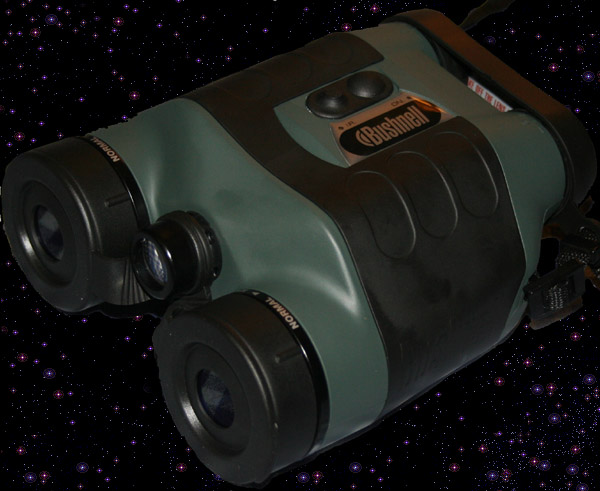 |
| Tube |
Lens |
Power |
Dimensions/weight |
Construction |
Type |
| Gen. I (18mm) |
42mm F 1.5 (2.5X) |
2 x AA |
6.5x6.3x3.0/ 28 oz |
Plastic. |
Night binoculars |
There is something wonderful about
looking through a good set of binoculars, particularly if they have a
large objective lens, and are being used at night. For decades, optics
manufacturers have been producing "night glasses" for naval and other
military observers, astronomers, hunters, outdoor enthusiasts, wildlife
observers, and anyone else who might have an interest in seeing a bit
better in the dark. These units typically have large objective lenses,
to gather and concentrate light; but there is a limit. The typical
borderline, over which a pair of binoculars are considered to be night
glasses, is 7 x 50; that is to say, a seven power scope, with a fifty
millimeter objective. During the Second World War, Japanese observers,
using huge 80mm binoculars, would often spot American ships at night,
before the American radar sets, those marvels of technology, would spot
the Japanese ships. I am working on a page explaining how and why this
works, and what the limits are; but that need not be covered in detail
here.
The Bushnell 26-0440 NVD binocular is a different kind
of night glass. Optically, it is rather bland, having rather small
objective lenses, and only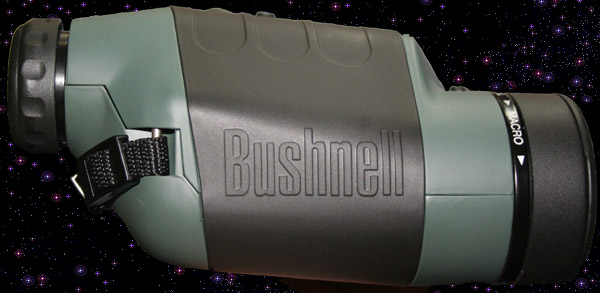 giving a magnification of 2.5, as opposed to
the more traditional seven and ten power, of the night glasses
traditionally used. The Bushnell, does offer a significant advantage
over these older styles, in that it is not limited to merely gathering
more light; it's electronic imagers do what the more traditional optics
of the older night glasses could not, and allow it to actually magnify
the light it has gathered. It also has the advantage of being able to
make infrared light visible to the human eye, and includes an infrared
light source. The I.R. light source is a focused LED, claimed to have an illumination
range, with this unit, of 90 yards. From testing this unit, out in the
woods, the claim seems accurate, and may even be a bit conservative. giving a magnification of 2.5, as opposed to
the more traditional seven and ten power, of the night glasses
traditionally used. The Bushnell, does offer a significant advantage
over these older styles, in that it is not limited to merely gathering
more light; it's electronic imagers do what the more traditional optics
of the older night glasses could not, and allow it to actually magnify
the light it has gathered. It also has the advantage of being able to
make infrared light visible to the human eye, and includes an infrared
light source. The I.R. light source is a focused LED, claimed to have an illumination
range, with this unit, of 90 yards. From testing this unit, out in the
woods, the claim seems accurate, and may even be a bit conservative.
This model is a true stereo binocular, with two
separate lens, focusing, prism, and imaging systems calibrated and
mounted side by side, and driven by a common set of AA batteries. It
uses a pair of 18mm imagers, producing a separate monochromatic green
image at each eyepiece. This is the color with which all users of night
vision devices have become familiar. It was not chosen at random. A
series of tests, decades ago, determined that the night adapted eye is
most sensitive to yellow green. It has thus been the color used in all
phosphor mixes for night vision devices.
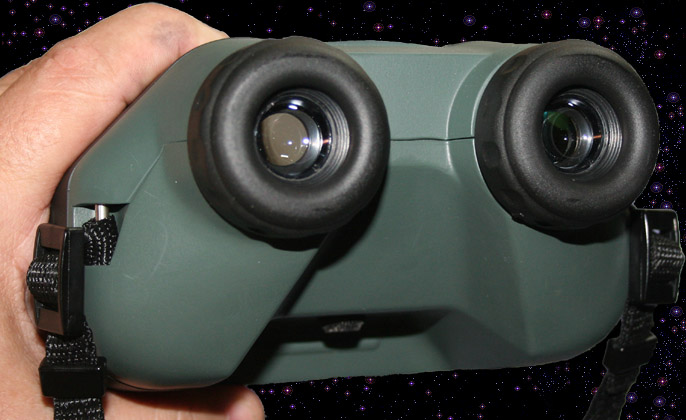 These are first generation units, as are nearly all
twin imager NVD units. The reasons for this are expense, and power consumption.
The second and third generation units, using twin eyepieces, tend to use
a single imager, and thus do not provide true stereo vision. First
generation units use tubes, and are notable for their edge distortion,
and relatively low resolution, and low sensitivity. This is why nearly
all first generation night vision devices include an infrared light
source. Performance is typical for a gen one unit, with no complaints or
surprises here. Image quality is pretty much identical to that of my
gen one Safari night viewer. These are first generation units, as are nearly all
twin imager NVD units. The reasons for this are expense, and power consumption.
The second and third generation units, using twin eyepieces, tend to use
a single imager, and thus do not provide true stereo vision. First
generation units use tubes, and are notable for their edge distortion,
and relatively low resolution, and low sensitivity. This is why nearly
all first generation night vision devices include an infrared light
source. Performance is typical for a gen one unit, with no complaints or
surprises here. Image quality is pretty much identical to that of my
gen one Safari night viewer.
The low power, of 2.5 magnifications, is also pretty
typical for an NVD binocular. It is rare to see such a device offering
more than four magnifications, and even this is not common, except on
NVD rifle scopes. Having used higher powered devices, the reason for the
low magnification becomes obvious. The higher the magnification of a
night scope, the more it's light gain becomes compromised. So there is
really no point. The F number of the objective lens (focal length
divided by aperture) determines it's brightness, and it is rather
difficult to make bright lenses with high magnification. Such lenses
tend to be less than sharp, and offer inferior contrast. These problems
may be solved by compounding the lens system; but you then start to
loose much of the light going through the lens, and greatly reduce
system gain. It is thus best to keep the lens system simple, and the
magnification low, due to the diminishing returns at higher
magnifications.
These binoculars do not focus in the manner of standard
optical binoculars. The oculars are focused to the requirements of the
users' eyes, and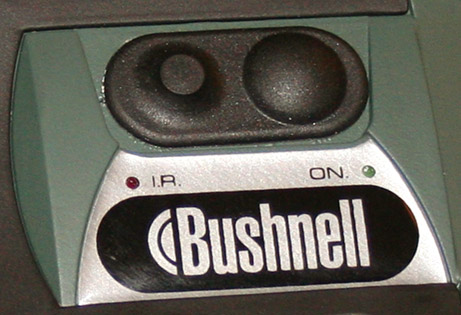 may be left alone, once set. Focusing for distance is
done by adjusting the focus of the objective lenses. The system works
this way, because it is not an integrated optical system, with the
objective linked to the ocular. Instead, the objective focuses an image
onto the front of the imager, which forms an amplified image at the rear
of the imager. The ocular is then focused on the rear of the imager. In
practice, the objectives will generally be focused on infinity, and then
let alone. The only other things that the user need be concerned with,
are the controls on top of the unit. They consist of the on/off switch
and the switch that turns on the infrared light source. The two switches
are shaped differently, making it easy to tell them apart in the dark. may be left alone, once set. Focusing for distance is
done by adjusting the focus of the objective lenses. The system works
this way, because it is not an integrated optical system, with the
objective linked to the ocular. Instead, the objective focuses an image
onto the front of the imager, which forms an amplified image at the rear
of the imager. The ocular is then focused on the rear of the imager. In
practice, the objectives will generally be focused on infinity, and then
let alone. The only other things that the user need be concerned with,
are the controls on top of the unit. They consist of the on/off switch
and the switch that turns on the infrared light source. The two switches
are shaped differently, making it easy to tell them apart in the dark.
Like most gen 1 night vision devices being sold today,
these binoculars are made in Russia. The consumer market for night
vision devices was pretty much created by surplus Russian gear, and this
gear still dominates, at least at the lower end. The Bushnell is
essentially a dressed up pair of Baigish military style binoculars,
housed in a nice plastic case. They are smoothly contoured, appear to be
of good quality, and have available warranty service in the U.S. They
are surprisingly light, and reasonably compact. The streamlined housing,
with controls on top, give it the look of something out of Star Wars.
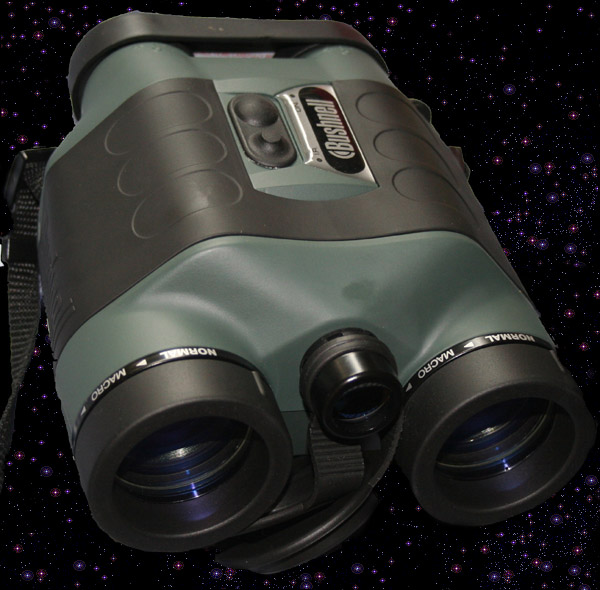 The unit takes standard AA batteries, and has a claimed battery life of
20 hours per set. The tubes charge up quickly, once the unit is powered
up, and will actually stay lit for a few minutes after the unit is
powered down, until the charge is dissipated. The unit has flash
protection, which is designed to quickly respond to bright sources of
light, and power the tubes down, to prevent damage. Even so, the manual
warns against pointing the unit at light sources, for any length of
time. The disadvantage to this is that it can sometimes make the tubes
flicker, which can be a bit disturbing. For daylight, testing, or city
use, the unit comes with a pair of daylight filters. Al large cover, for
the eyepieces is looped to the neck strap, and there is also the
provision for mounting the unit to a tripod. A very basic manual, in six
languages, is included, and the unit is also packed with a fairly nice,
nylon carry case.
The unit takes standard AA batteries, and has a claimed battery life of
20 hours per set. The tubes charge up quickly, once the unit is powered
up, and will actually stay lit for a few minutes after the unit is
powered down, until the charge is dissipated. The unit has flash
protection, which is designed to quickly respond to bright sources of
light, and power the tubes down, to prevent damage. Even so, the manual
warns against pointing the unit at light sources, for any length of
time. The disadvantage to this is that it can sometimes make the tubes
flicker, which can be a bit disturbing. For daylight, testing, or city
use, the unit comes with a pair of daylight filters. Al large cover, for
the eyepieces is looped to the neck strap, and there is also the
provision for mounting the unit to a tripod. A very basic manual, in six
languages, is included, and the unit is also packed with a fairly nice,
nylon carry case.
Despite the clean design, and futuristically contoured
case, the heart of the system is the Baigish NVD binocular, designed
forty years ago. So this hardly qualifies as high tech, and has all of
the disadvantages of any first generation Russian unit, as are mentioned
above. What it has going for it, is true stereo night vision, at a
reasonable price (around $400 - $500), and in a fairly small, and light
package. Though there are now a few second , and even third, generation
NVD binoculars coming onto the civilian market, they tend to be
extremely expensive. Perhaps in a few years their costs will come down;
but I doubt it. The price of NVD gear seems to have bottomed out, maybe
7 -8 years ago, and has been slowly rising ever since.
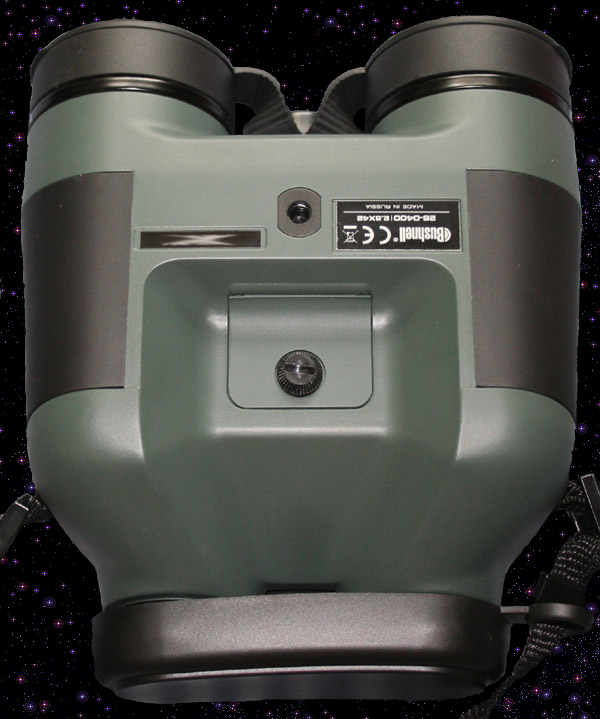 |